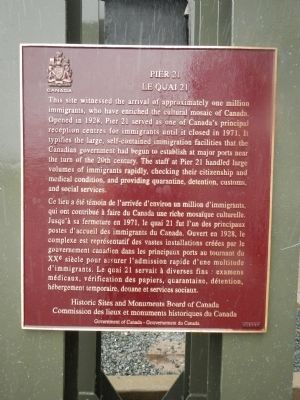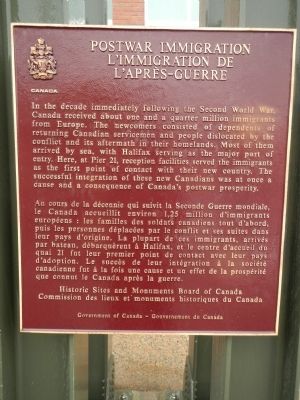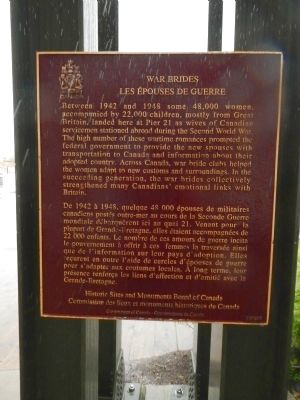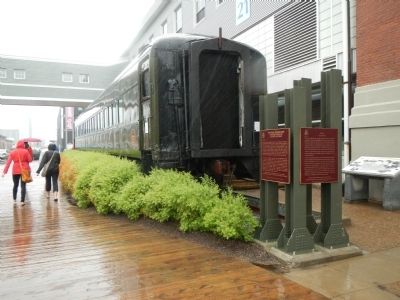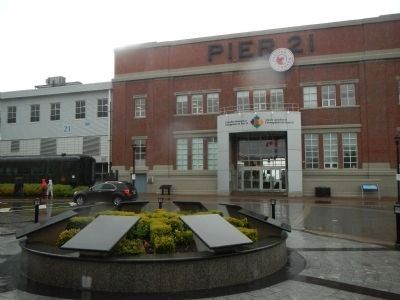Halifax in Halifax Region, Nova Scotia — The Atlantic Provinces (North America)
Pier 21 / Le Quai 21
Postwar Immigration / L’immigration de L’aprés-guerre
— War Brides / Les Epouses de Guerre —
English
This site witnessed the arrival of approximately one million immigrants, who have enriched the cultural mosaic of Canada. Opened in 1928, Pier 21 served as one of Canada’s principal reception centres for immigrants until it closed in 1971. It typifies the large, self-contained immigrant facilities that the Government of Canada had begun to establish at major ports near the turn of the 20th century. The staff at Pier 21 handled large volumes of immigrants rapidly, checking their citizenship and medical condition, and providing quarantine, detention, customs and social services.
French
Ce lieu a été témoin de l’arrivée d’environ un million d’immigrants, qui ont contribué à faire du Canada une riche mosaïque culturelle. Jusque’à sa fermeture en 1971, le quai 21 fut l’un des principaux postes d’accueil des immigrants du Canada. Ouvert en 1928, le complexe est représentatif des vastes installations créées par le gouvernement canadien dans les principaux portes au tournant du XXᵉ siècle pour assure l’admission rapide d’une multitude d’immigrants. Le quai 21 servait à diverses fins : examens médicaux, vérification des papiers, quarantaine, détention, hébergement temporaire, douane et services sociaux.
English
In the decade immediately following the Second World War, Canada received about one and a quarter million immigrants from Europe. The newcomers consisted of dependents of returning Canadian service men, a people dislocated by the conflict and its aftermath in their homelands. Most of them arrived by sea, with Halifax serving as the major port of entry. Here, at Pier 21, reception facilities served the immigrants as the first point of contact with their new country. The successful integration of these new Canadians was at once a cause and a consequence of Canada’s postwar prosperity.
French
Au cours de la décennie qui suivit la Seconde Guerre mondiale, le Canada accueillit environs 1,25 million d’immigrants européens : les families de soldats canadiens tout d’abord, puis les personnes déplacées par le conflit et ses suites dans leur pays d’origine. Le plupart de ces immigrants, arrivés par bateau, débarquèrent à Halifax, et le centre d’accueil de quai 21 fut leur premier point de contact avec leur pays d’adoption. Le succès de leur integration à la société canadienne fut à la fois une cause et un effet de la prospérité que connut le Canada après la guerre.
English
Between
1942 and 1948 some 48,000 women, accompanied by 22,000 children, mostly from Great Britain, landed here at Pier 21 as wives of Canadian servicemen stationed abroad during the Second World War. The high number of these wartime romances prompted the federal government to provide the new spouses with transportation to Canada and information about their adopted country. Across Canada, war bride clubs helped the women adapt to new customs and surroundings. In the succeeding generations, the war brides collectively strengthened many Canadian’s emotional links with Britain.
French
De 1942 à 1948, quelque 48,000 épouses de militaires canadiens postés outre-mer au cours de la Seconde Guerre mondiale débarquèrent ici au quai 21. Venant pour la plupart de Grande-Bretagne, elles étaient accompagnées de 22,000 enfants. Le nombre de ces amours de guerre incita le gouvernement à offrir à ces femmes la traversée ainsi que de l’information sur leur pays d’adoption. Elles récurent en outre l’aide de cercles d’épouses de guerre pour s’adapter aux coutumes locales. À long terme, leur présence renforça les liens d’affection et d’amitié avec la Grande-Bretagne.
Erected 1999 by Heritage Trust of Nova Scotia.
Topics and series. This historical marker is listed in these topic lists: Settlements & Settlers • War, World II. In addition, it is included in the Canada, Historic Sites and Monuments Board series list. A significant historical year for this entry is 1928.
Location. 44° 38.303′ N, 63° 33.921′ W. Marker is in Halifax, Nova Scotia, in Halifax Region. Marker is on Marginal Road. Touch for map. Marker is at or near this postal address: 1055 Marginal Road, Halifax NS B3H, Canada. Touch for directions.
Other nearby markers. At least 8 other markers are within walking distance of this marker. Building a Nation / L'édification d'une nation (here, next to this marker); Passage to a New Beginning • Passage à un nouveau monde (here, next to this marker); Canadian Museum of Immigration at Pier 21 (a few steps from this marker); Dutch Canadians of Nova Scotia (within shouting distance of this marker); Lest We Forget (within shouting distance of this marker); Ruth M. Goldbloom, O.C., O.N.S. (1923- 2012) (within shouting distance of this marker); Polish Immigration Memorial (within shouting distance of this marker); British Home Children / Petits Immigres Britanniques (within shouting distance of this marker). Touch for a list and map of all markers in Halifax.
Also see . . . Immigration - The Canadian Encyclopedia. The story of Canadian immigration is not one of orderly population growth; it has been and remains both a catalyst to Canadian economic development and a mirror of Canadian attitudes and values; it has often been unashamedly and economically self-serving and ethnically or racially biased. (Submitted on October 5, 2014, by Barry Swackhamer of Brentwood, California.)
Additional keywords. immigration
Credits. This page was last revised on July 23, 2020. It was originally submitted on October 5, 2014, by Barry Swackhamer of Brentwood, California. This page has been viewed 444 times since then and 16 times this year. Photos: 1, 2, 3, 4, 5. submitted on October 5, 2014, by Barry Swackhamer of Brentwood, California. • Andrew Ruppenstein was the editor who published this page.
